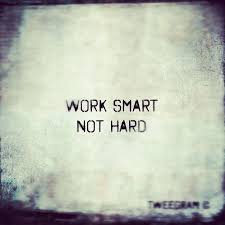Method 1 of 4: Prioritize
1. Assess everything that needs to be done. Before you plunge into something headfirst, remember that enthusiasm needs to be tempered with wisdom. Look over every aspect of the job, and allow yourself ample “pondering time” so that you can be sure that every detail is accomplished on time and accurately.
2. Make an outline. Whether it’s in your head or on paper, you should have a checklist in mind and follow it in order. You don’t want to repeat steps, duplicate the efforts of others, make mistakes or forget anything.
3. Learn to say no. Avoid over-scheduling yourself and be realistic about what you can accomplish in a single day. Sometimes you just have to cut yourself off because in most professions, there is almost always something that could be done.
4. Limit your goals. Try to avoid multi-tasking because you often get less done since your brain is switching back and forth between tasks. Pick one thing to work on and put your best effort into that until it is accomplished.
Method 2 of 4: Dealing With Clients
1. Control clients by communicating properly. Make sure your clients will understand what the normal turnaround time will be for a project. Do not be influenced by their insistence that their job requires a big rush. Most businesses have more than one client, yet many clients forget that their job is not the only one you’re working on. • Give one to three choices – never more. Handing a swatch book to a client and saying, “Tell me which colors you are interested in” is deadly. Too many choices will cause horrible delays as the customer peruses ALL possibilities and later tends to second-guess every decision. Instead, say things like, “Do you like this blue or this green better?”
2. Never accept a bad job. You know when a job is going to be great. A client or boss who pressures you into areas where you are not comfortable, either because it is an unreasonable expectation or because it’s outside your scope, needs to be made immediately aware of your discomfort with the job as proposed. If you are self-employed, declining a job like this is much smarter even though it’s hard to let money go.
3. Re-bid if necessary. Don’t accept so many changes that you end up doing a much more complicated or expensive job than you bid for. When you realize you’re into new territory, stop work and draw up a re-bid, showing the entire job as originally envisioned and overlay the scope of the new work. Let the client know it will cost $x more than the original bid to proceed. It’s the client’s decision how much to pay. How smart you want to be while you’re working for them is your decision.
Method 3 of 4: Getting More Done In Less Time
1. Consider your materials. Don’t take shortcuts on the quality of your materials. Cheap materials or tools are harder to work with because they aren’t as sturdy or nice. Trying to save a few bucks, but spending an extra hour or two because those cheap things didn’t install properly doesn’t make any sense.
2. Evaluate your methods. You want them to be as efficient as possible. Do your work when you have no distractions surrounding you. Try to do things in one batches rather than one at a time. You want your efficiency to be maximized as much as possible.
3. Look for shortcuts. This does NOT mean taking the easiest method for the sake of it or being lazy. For example, if you respond to numerous e-mails per day and answer the same questions again and again, save your responses. When those questions come up, you can cut and paste your canned response. You might have to make minor edits, but the bulk of it will already be written.
4. Delegate to the right people at the right times. Make sure your team is well-ordered. If one person is faster, put him or her on the part of your task that will take longest. If one person is more skilled and accurate, put him or her on the part of the task that is most critical.
5. Avoid procrastination. Every time you surf the net or needlessly check e-mail at work, your day becomes longer. Push yourself hard to do work when it’s time to do work and enjoy these activities once you’re done for the day.
6. Be flexible. Your day will not always go as planned. Be open to trying new methods and doing new things.
Method 4 of 4: Take Care of Yourself
1. Rest. You should ideally be getting eight hours of sleep every night. You can certainly pull continuous 12 hour days at work, but it’s not sustainable. After a certain point, your body becomes tired and your mind wears down, leading to more frequent lapses in concentration and careless mistakes.
2. Periodic breaks. Even at the office, you need to allow time for your mind to regroup and recharge. Push yourself hard for the first 50 minutes of every hour and then reward yourself with a 10 minute break.
3. Recognize the point of ‘diminishing returns.’ The above steps do not imply that you should work yourself to the point of exhaustion. You need to protect your health and the integrity of your job. Working yourself to a frazzle constantly makes you prone to mistakes. When you’re so tired that you realize it’s taking you twice or three times longer to do a job than normal, you need to call it a day. Rest at least a few hours and come back fresher, so that you can be strong at the end of the job. Learn how to power nap.




